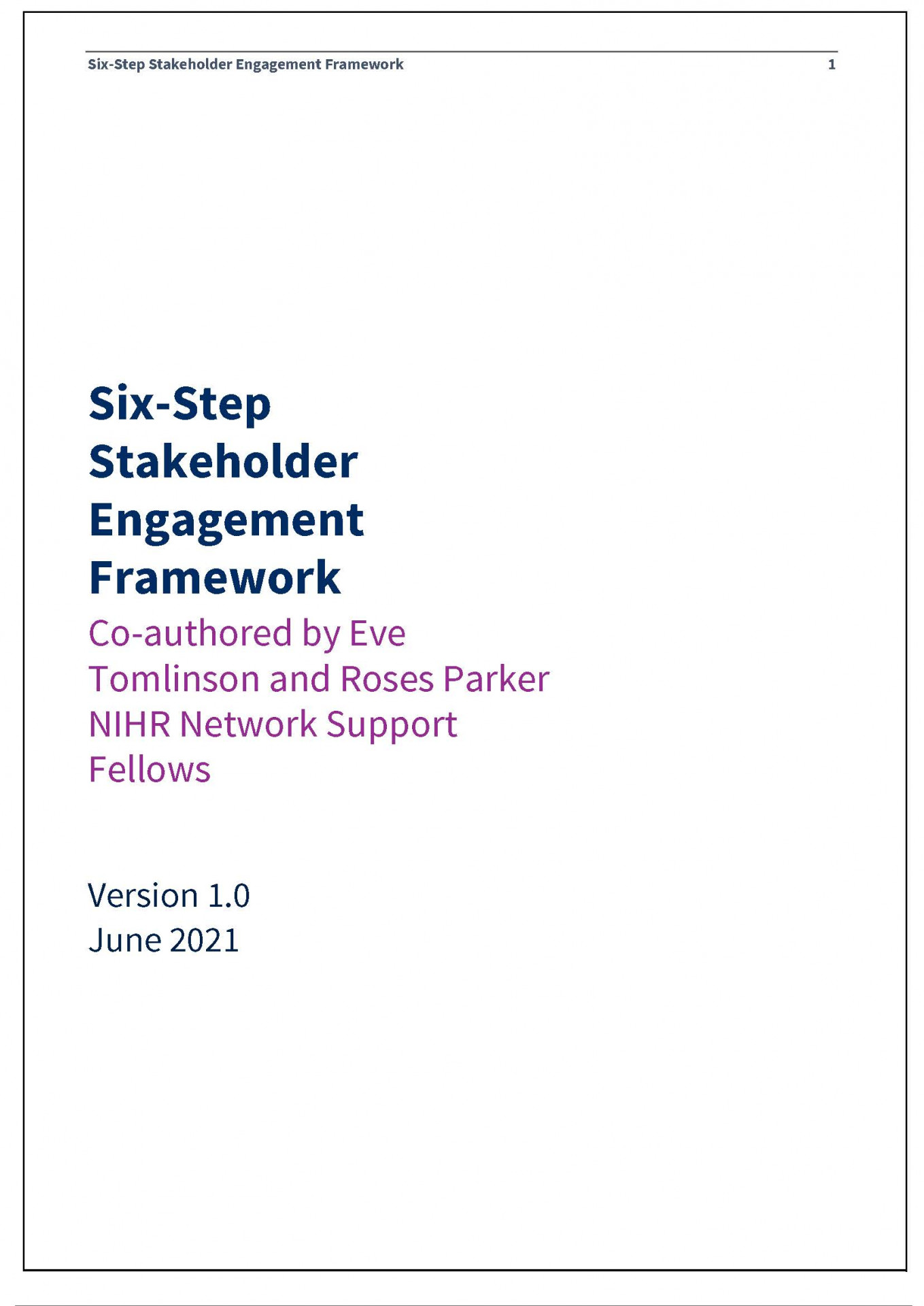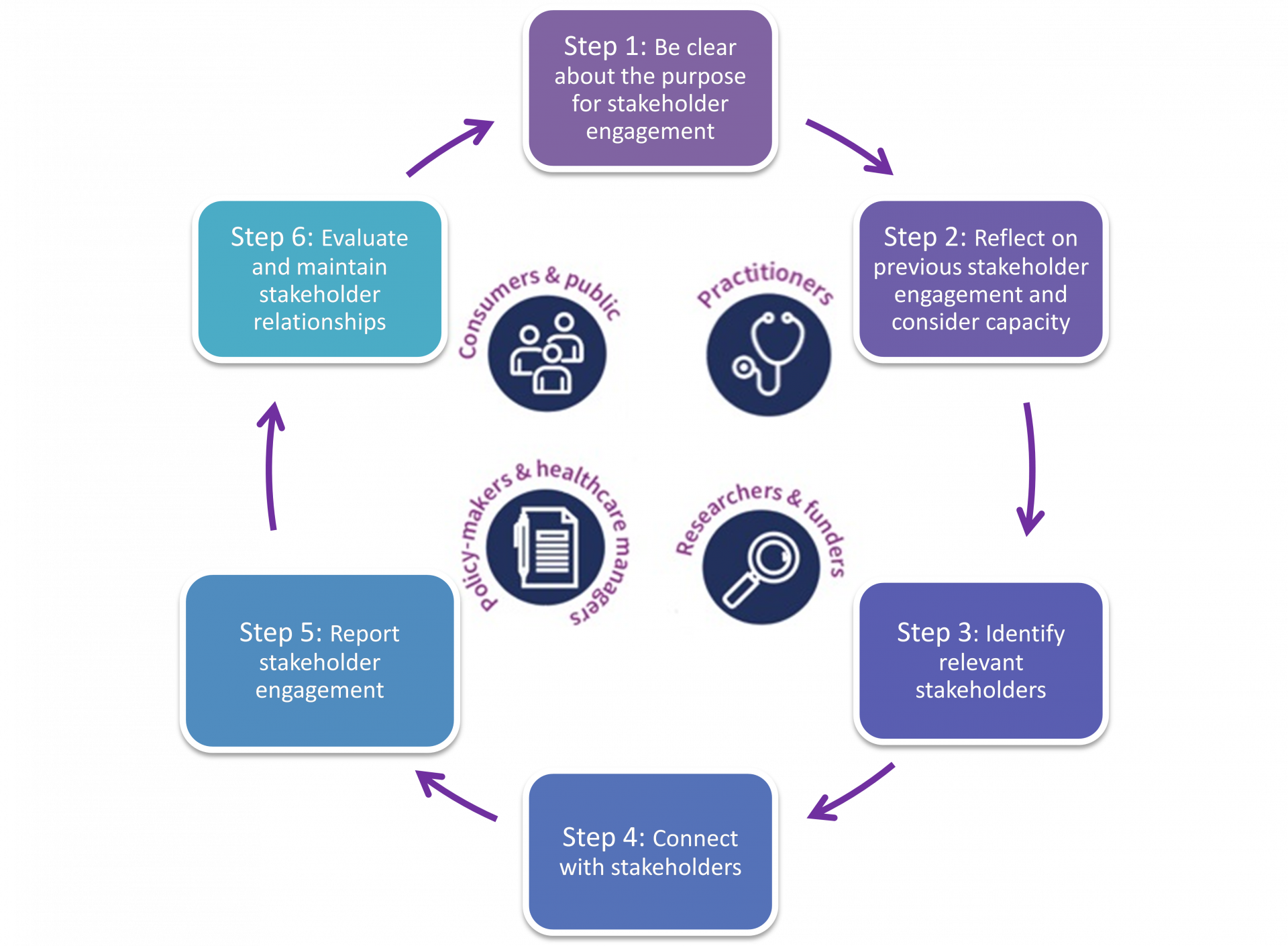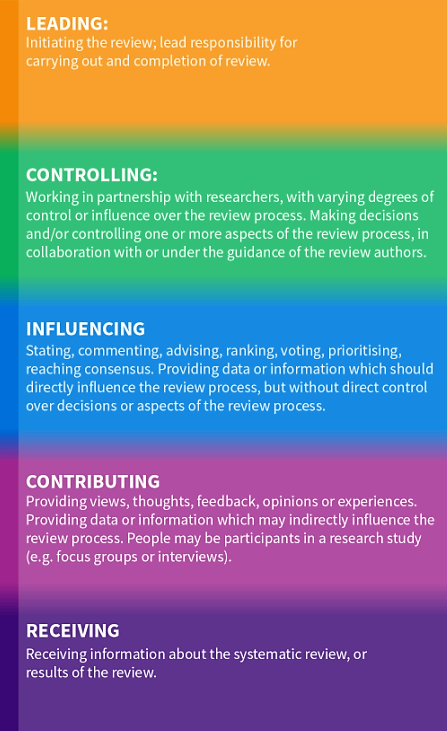 Working with stakeholders can make our work more relevant and useful for end audiences and may increase the reach and ultimate impact of our Cochrane Reviews. However, knowing where to start with stakeholder engagement can be daunting. This page presents a Six-Step Stakeholder Engagement Framework which is one way of thinking about working with stakeholders.
Working with stakeholders can make our work more relevant and useful for end audiences and may increase the reach and ultimate impact of our Cochrane Reviews. However, knowing where to start with stakeholder engagement can be daunting. This page presents a Six-Step Stakeholder Engagement Framework which is one way of thinking about working with stakeholders.
The framework has been produced by Roses Parker and Eve Tomlinson, the Network Support Fellows for the Cochrane Musculoskeletal, Oral Skin and Sensory (MOSS) Network and the Cochrane Cancer Network. The framework is based on experiences of stakeholder engagement from Cochrane Review Groups (CRGs) in the Cochrane MOSS Network (full report available here) and from conversations with CRGs and experience from a stakeholder identification project in the Cochrane Cancer Network (information here). This page summarises some suggestions and things to think about, but more information is available in the full framework document.
Who are the stakeholders?
A stakeholder is any individual or organisation who has an interest or who is affected by a specific issue. Within Cochrane knowledge translation we can think of stakeholders in relation to the four target audiences that are defined by the Knowledge Translation Framework:
- Consumers and the public,
- Practitioners,
- Policy makers and healthcare managers, and
- Researchers and research funders.
A stakeholder may be an individual or an organisation who represents the needs of individuals.
What is stakeholder engagement?
Stakeholder engagement is about connecting with individuals and organisations to consider and understand their views, and work together to improve the work of Cochrane. There are many ways stakeholders can be involved in Cochrane’s work. Examples include a quick, one-time engagement (such as an informal discussion), asking the opinion of a wide range of people or organisations (e.g. surveys or focus groups), working with individuals in the co-production of Cochrane reviews, and developing formal partnerships with stakeholder organisations. The mechanism that you choose will be based on your needs, resources capacity and the size of your project.
Good principles for working with stakeholders
A good starting place for working with stakeholders is Cochrane’s Involving People online resource. This starts with some general good practice when involving people. Although this is written through the focus of involving people in systematic reviews, the points covered can be applied more widely – and to organisations as well as individuals.
The Six-Step Stakeholder Engagement Framework

The Framework provides a way of thinking about stakeholder engagement aiming to be comprehensive but flexible. It was designed to highlight some of the important issues to think about before and whilst working with stakeholders. It can be used for a range of different situations aware that researchers may not have much resources for this activity, and adaptable for involving individuals or stakeholder organisations. The sections below summarise some of the key points of the Framework. However, there is more information about each step, how the Framework was developed and a list of useful resources in the full document.
There are six steps:
- Step 1: Be clear about the purpose of stakeholder engagement
- Step 2: Reflect on previous stakeholder engagement and consider capacity
- Step 3: Identify relevant stakeholders
- Step 4: Connect with stakeholders
- Step 5: Report stakeholder engagement
- Step 6: Evaluate and maintain stakeholder relationships
 Step 1: Be clear about the purpose of stakeholder engagement
Step 1: Be clear about the purpose of stakeholder engagement
There are many different activities where stakeholders could (and should) be involved.
It may be useful to think about two key questions:
- What is the desired mode of stakeholder involvement in your work?
- What is the desired level of stakeholder involvement in your work? The levels of engagement from the ACTIVE framework may help you think about this.
The ACTIVE continuum of involvement (Pollock 2019) may help think about different levels of stakeholder engagement.
One of the best ways to help answer these questions is to talk to some of the stakeholders to understand how, and to what level, they would like to be involved. More guidance is provided in the full Framework document.
Examples of ways the Cochrane Review Groups in the MOSS Network have involved stakeholders are presented in the audit report.
Step 2: Reflect on previous stakeholder engagement and consider capacity
Before making detailed plans for how to engage stakeholders in your work it may be helpful to think about what has worked well previously, and areas which you may try to improve.
It is also important to be realistic about the time, skills and resources required to meaningfully include stakeholders in your work. This should not be underestimated. It may be preferable to adapt plans in line with resources that you have.
Support for developing skills in involving stakeholders may be available through talking to groups (both within, and external to, Cochrane) who have run similar projects for engaging stakeholders. For involving consumers, Cochrane has a Consumer Network who may be able to support your work.
Step 3: Identify relevant stakeholders
This step will be different according to whether you are looking to engage individuals or organisations, and on the size and complexity of the project you are running. Three questions that could help you understand who to involve in your work were suggested by Concannon et al (2019) as:
- What decisions do the stakeholders make?
- How are the stakeholders affected by your work?
- What is the number of people you would like to, and can realistically, engage (considering budget)?
For large projects which will involve multiple stakeholders (usually organisations) you may want to run a ‘stakeholder mapping’ exercise. Suggestions for how to complete are provided in the full Framework document. This case study of stakeholder mapping presents the work to map stakeholders across the Cancer Cochrane Review Group Network.
When you are looking to work with individuals you may need to use your known contacts or volunteering platforms (such as Cochrane’s TaskExchange) to try to identify people who may be interested in getting involved.
In all cases you should consider the issue of equity. It may be easy to find some people who are interested to support the work, but it is important to consider whether these people are similar to the people who will be affected by the work. It often takes more time and effort to reach out to those people who don’t normally engage with supporting Cochrane, but there will be benefits in doing so.
It's important to remember that each individual brings a unique set of experiences and cannot be expected to represent all views within a stakeholder group.
Step 4: Connect with Stakeholders
The full guidance document provides lots of suggestions for how to connect with stakeholders. If you don’t have much time or resources for engagement some useful tips might include:
- Use your existing networks: can they help put you in touch with people who might want to help? Don’t forget other Cochrane Groups, including Fields and Geographic Groups!
- Use networking events (even online events): relationships always start with the person – use opportunities to talk to people to find out more about them and whether they might want to help.
- Use Cochrane TaskExchange: there are many people who are interested in helping across the world who use this platform.
- Use Cochrane Consumer Network: there is a network of nearly 2,000 consumers in 80 countries in Cochrane who may want to get involved, or know of others who might want to help. The consumer webpage provides more information.
- Use peer review: are there people who have helped with peer review interested in supporting the dissemination of the review, or getting involved in reviews on similar topics?
- Social media: Tagging charities, organisations, and key individuals in your social media can be a helpful way to increase awareness in your work and reach out to people who might want to be involved.
- Register with other organisations (such as guideline developers): some groups have stakeholders lists which provide the opportunity to share news about work on the topic.
Step 5: Report Stakeholder Engagement
Transparent reporting of stakeholder engagement is crucial to ensure fair acknowledgement of stakeholder time and effort. It can also support the evaluation of stakeholder engagement. The ACTIVE framework provides guidance for reporting consumer involvement in systematic reviews which could be adapted to other stakeholders. The GRIPP2 reporting checklist is for reporting patient and public involvement in research more widely.
Acknowledging stakeholder input
Timely, clearly presented feedback to those involved in the work, is usually highly valued by the stakeholders involved. Stakeholders are likely to be interested in how their contribution has been considered, what has changed as a result and what has been learnt. Stakeholder contributions should always be acknowledged appropriately. Remember to thank the people you have worked with, especially your volunteers.
Individuals may be entitled to Cochrane membership points for their contributions. To find out more you can contact the Cochrane Support Team.
Step 6: Evaluate and Maintain Stakeholder Relationships
Evaluation
At appropriate times during the work, it is useful to reflect on whether a stakeholder relationship is achieving the objectives originally intended. Evaluation does not need to be complex. Regular and informal feedback from the stakeholder may be sufficient to understand whether both parties feel engagement is working. More guidance for evaluating KT activities is available on the Cochrane Website.
Maintenance
Maintaining relationships with stakeholders takes time. Regular emails, calls or including stakeholders in a newsletter may help keep the stakeholders up to date with the latest information from the Cochrane Group.
For organisations where the relationships are strong and with mutual benefit, it might be appropriate to think about developing a formal partnership with them. Equally with other organisations the priorities may evolve, people may change roles or leave. For individuals, their circumstances may change meaning that they are no longer able or want to be involved in the work. In all of these cases the Group will have to adapt their plans and it may be appropriate to close the partnership.
Cyclical stakeholder engagement
It is useful to view the stakeholder engagement process as an ongoing process. It is important to remember that Step One follows Step Six, as every project has potential value for the next project. Stakeholders continue to have valuable input in supporting Cochrane’s mission and values. Once you have considered and conducted evaluation and maintenance of stakeholder relationships, it is useful to consider again the purpose of stakeholder engagement and how your next engagement will be conducted.
Other resources
The Framework document provides a list of resources in Section 4.
A selection of key Cochrane resources is listed below:
Involving People: A learning resource for systematic review authors
Involving People is a resource for systematic review editors and authors to support you in getting people involved in the production of your reviews (including Cochrane Consumers: patients, their families and carers, as well as other members of the public; and health care teams).
The resource is a 'one-stop-shop' for you to find out best practice and practical suggestions for finding and involving people throughout the review process; including useful resources, guidance documents, interviews about first hand experiences, and links to case studies and examples of good practice.
Access the resource here.
Introduction to knowledge translation (KT) in Cochrane
Cochrane defines knowledge translation (KT) as the process of supporting the use of health evidence from our high quality, trusted Cochrane Reviews by those who need it to make health decisions. We have developed an online resource to help explain what we mean by ‘knowledge translation’ in Cochrane. This includes stakeholder engagement and involvement.
Access the resource here.
Cochrane Learning Live Consumer involvement collection
Recordings of a series of online learning events, open to everyone on a wide range of stakeholder engagement and involvement topics from an introduction to consumer involvement to measuring impact.
Access the resource here.
TaskExchange
Cochrane’s volunteering platform, TaskExchange, connects people working in health evidence with stakeholders who have the time and skills to help.
Access the resource here.

